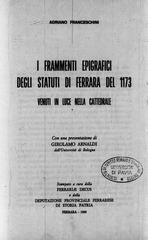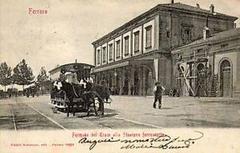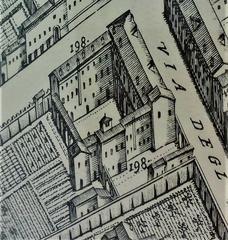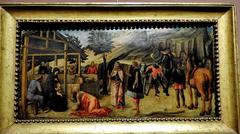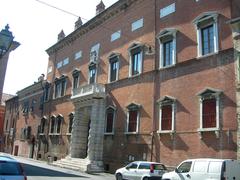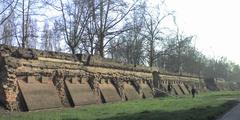Baluardo di San Paolo alla Fortezza: Visiting Hours, Tickets, and Historical Guide – Ferrara, Italy
Date: 14/06/2025
Introduction
The Baluardo di San Paolo alla Fortezza is a striking example of Renaissance and Baroque military architecture, set within the historic city of Ferrara, Italy. As part of Ferrara’s extensive fortification system, this bastion traces the city’s evolution from a strategic Este stronghold to a papal fortress and, finally, to a vibrant urban park. Today, it stands not only as a symbol of military innovation and resilience but also as a focal point for cultural activities and historical reflection. Whether you’re drawn by its imposing design, panoramic views, or lively festivals, this guide will help you make the most of your visit—covering history, practical tips, accessibility, and nearby attractions (Ferrara Terra e Acqua, Museo Ferrara, UNESCO World Heritage Centre).
Table of Contents
- Historical Background and Construction
- Architectural Design and Features
- Strategic Significance and Evolution
- Restoration and Present-Day Role
- Visiting Information: Hours, Tickets, Accessibility
- Events and Cultural Activities
- Points of Interest and Amenities
- Travel Tips and Nearby Attractions
- Frequently Asked Questions (FAQ)
- Preservation and Community Engagement
- Plan Your Visit
- References
Historical Background and Construction
Origins and Strategic Context
Ferrara’s strategic position along the Po River made it a vital defensive and commercial hub. The city’s fortifications were modernized by the Este family in the late 15th and early 16th centuries, responding to the increasing threat of artillery. The Baluardo di San Paolo was conceived as part of these efforts, later integrated into the pentagonal papal fortress built after Ferrara’s transition to Papal rule in 1598 (Comune di Ferrara, Ferrara Terra e Acqua).
Construction Timeline and Key Figures
The bastion’s construction began around 1585 and culminated during the fortress works of 1608–1618, under the direction of architect Giovanni Battista Aleotti, with oversight by Mario Farnese and Pompeo Targone. Its design reflected cutting-edge military concepts, including angular bastions, thick ramparts, and a star-shaped layout (Museo Ferrara, Antica Ferrara).
Architectural Design and Features
Layout and Structure
The Baluardo di San Paolo, paired with the adjacent Baluardo di Santa Maria, represents the last visible evidence of the pentagonal Fortezza Pontificia. Its massive earthwork and masonry construction were designed to deflect cannon fire and maximize defensive coverage. A wide moat, supplied by the Canalino di Cento, surrounded the fortress, enhancing its impregnability (Museo Ferrara).
Materials and Techniques
Brick, stone, and packed earth formed thick ramparts, with the outer faces sloped to resist bombardment. The terreplein provided space for artillery, while internal casemates sheltered troops and supplies (Antica Ferrara).
Associated Structures
- Porta Paola: Main city gate, built in 1612 by Aleotti, protected by the San Paolo and San Lorenzo bastions (Ferrara Info).
- Statue of Pope Paul V: Originally installed within the fortress in 1618, now stands atop the terreplein.
- Remnants of the Church of Santa Maria dell’Annunziata: Destroyed in WWII, once a key element of the fortress’s internal life.
Strategic Significance and Evolution
The Baluardo di San Paolo embodied the shift from medieval to modern military architecture. Its angular design and integrated defensive systems made the fortress nearly impregnable in its day, serving both as protection against external threats and as a symbol of papal authority after 1598 (Wikipedia). Over time, as military needs changed and fortifications became obsolete, the fortress was gradually dismantled—except for the bastions of San Paolo and Santa Maria, which were preserved and eventually repurposed for public use.
Restoration and Present-Day Role
Conservation Efforts
Extensive restoration in the late 20th century revitalized the Baluardo di San Paolo, integrating it with Ferrara’s green belt. The “Progetto Mura” initiative saw masonry repairs and landscaping, transforming the ramparts into a park and open-air museum (Museo Ferrara).
Urban and Cultural Significance
Today, the bastion is a beloved urban landmark, offering walking and cycling paths, interpretive panels, and venues for cultural events. Community advocacy, notably by Ferrariae Decus, has been essential in safeguarding and promoting the site (Ferrara Terra e Acqua).
Visiting Information: Hours, Tickets, Accessibility
Opening Hours and Tickets
- Hours: The Baluardo di San Paolo is open year-round, accessible daily from dawn to dusk as part of Ferrara’s public park system.
- Tickets: Entry is free. Guided tours, when available, may require advance booking and a small fee.
Accessibility
The site features mostly flat, paved paths suitable for wheelchairs and strollers, though some uneven surfaces exist near historic masonry. Assistance can be requested via local tourist offices.
Events and Cultural Activities
The bastion is a lively hub during the annual “Giostra del Monaco” festival (late August–early September), which transforms the area into a medieval village with tournaments, performances, and traditional cuisine (lagiostradelmonaco.it). Other events include historical reenactments, open-air concerts, and community gatherings.
Points of Interest and Amenities
- Memorial Obelisk: Marble monument honoring Ferrara’s Risorgimento martyrs, inaugurated in 2011.
- Statue of Pope Paul V: Restored marble statue, a relic of the original fortress.
- Panoramic Walks: Elevated views over Ferrara and the Po River.
- Cycling Routes: Integrated with Ferrara’s extensive bike paths.
- Restrooms: Available during major events and in nearby parks.
- Food: Festival taverns operate during events; city center cafes are a short walk away.
Travel Tips and Nearby Attractions
- Getting There: Easily reached on foot, by bike, or by public transport from Ferrara’s center and train station. Parking is available along Viale IV Novembre and in nearby lots.
- Best Time to Visit: Spring and autumn offer pleasant weather. Evening visits during festivals provide a unique atmosphere.
- Nearby Sites: Combine your visit with Porta Paola, other segments of the Renaissance walls, Este Castle, and the city’s UNESCO-listed historic core.
Frequently Asked Questions (FAQ)
Q: What are the opening hours?
A: Open daily, dawn to dusk.
Q: Is there an entrance fee?
A: No, access is free.
Q: Are guided tours available?
A: Yes, periodically—check with local tourist offices or the Museo Ferrara website.
Q: Is the site accessible to wheelchairs and strollers?
A: Most paths are accessible, though some uneven areas remain.
Q: Are dogs allowed?
A: Yes, the park is dog-friendly.
Q: Are there restrooms and food options?
A: Restrooms are available during events; food is offered at festival taverns and in the city center.
Preservation and Community Engagement
The Baluardo di San Paolo’s continued vitality reflects the efforts of local authorities, heritage organizations, and citizen groups. Regular restoration, educational programming, and community events ensure that the bastion remains both a monument to Ferrara’s storied past and a dynamic part of its present (Museo Ferrara, Ferrara Terra e Acqua).
Plan Your Visit
- Explore more: Visit Ferrara Terra e Acqua for themed itineraries.
- Download the Audiala app for audio guides, maps, and updated event information.
- Stay informed: Follow local tourism sites and social media for the latest on festivals, restoration projects, and guided tours.
References
- Ferrara Terra e Acqua
- Museo Ferrara
- UNESCO World Heritage Centre
- Antica Ferrara
- Ferrara Info
- Lagiostradelmonaco.it
- Wikipedia: Fortezza di Ferrara
